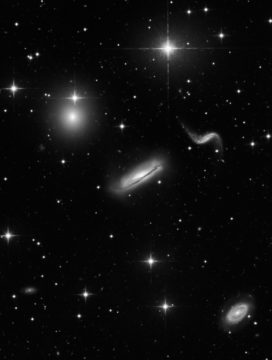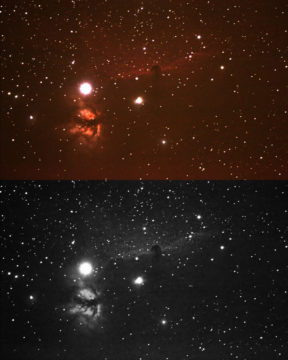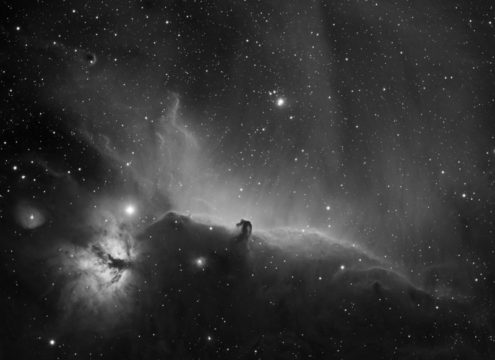Quality monochrome (black-and-white) images are a much easier route to early success in astrophotography — find out how to get started.
I work in the business of astrophotography, and one of the things my peers and I often discuss is how to make imaging easier for beginners. With some teaching experience, I also have the vanity to think that I may have picked up on some things about how people learn, and how to get them successful early so that they want to keep on learning, even when it starts getting “hard.”
Let’s face it, nobody gets into astrophotography because it’s a nice, quiet, and relaxing way to spend an evening. It’s work. It’s challenging and rewarding work, but it’s work none-the-less. If it weren’t hard, no one would be impressed with the fact that you took a photo of a galaxy from your back yard!

Richard S. Wright Jr.
That said, we rarely jump into the deep end of the pool when learning to swim. For beginners getting into deep sky imaging, we essentially have a core set of recommendations to avoid frustration and ensure early success. The top four recommendations are typically as follows:
1. Short focal-length optics
2. Fast focal-ratios
3. Avoid tiny pixels
4. Use a color camera instead of mono with filters
This combo will get as much light on your sensor as possible as quickly as possible. The pixel scale is sensitive and forgiving of tracking problems, polar alignment errors, and other issues associated with low-end entry-level gear.
Number 4 though . . . I have to disagree with. It’s based on the assumption that beginners need to be producing color images right away. I believe color imaging should be considered an intermediate to advanced skill. If you're a rank beginner, the best way to learn quickly (and with confidence) is to shoot with a monochrome camera. If you only have a color camera (such as a DSLR), that's fine, but start by converting your images to black and white anyway.
A surprising number of people first come to photography through astrophotography. They’ve not learned to color balance daytime photos yet, much less a low-light astrophoto. I think we can drastically lower the bar for early success by not fostering that idea that everything has to be in “living color.”

Richard S. Wright Jr.
I dug back into my archives for some of my earliest modified DSLR images. Let me tell you, they are hideous! When first getting started in astrophotography, making good color images is hard. Exhibit A is my first ever image of the Horsehead Nebula (Barnard 33). I was pretty proud that I could see the Horsehead (actually getting the target on the sensor was a feat back then). But I was also embarrassed because I knew the color looked terrible, and I didn’t yet know how to fix it. Now, look what happens when I convert it to black and white. I think the Horsehead is actually easier to see in this image, as it has far more contrast. Moreover, it makes for a more pleasing picture.
Even today, more than 15 years later, I sometimes look at my one-shot-color data… and then just make it black and white. You don’t need as much data to make a pleasing black and white image, but you do need deep data, regardless of your camera type to make good color images.
Monochrome Advantages
There are several other advantages to shooting mono. For starters, monochrome cameras are far more sensitive than color cameras, if you compare the same sensors. That means you can get good data and better signal-to-noise-ratio with far less exposure time. The increased sensitivity reduces the demands not only on your time, but also on how long you may need to go before employing an autoguider. (I also think auto-guiding is something beginners should avoid . Too many things to go wrong and obsess over!)
Without worrying about the different color channels, beginners can focus on learning to properly calibrate their images, stretch them, get a handle on how histograms and contrast enhancements work, learn to battle noise, and maybe even learn some fancy tricks about sharpening and deconvolution.

Richard S. Wright Jr.
To push yourself further, try shooting through a narrowband hydrogen-alpha filter. A wider bandpass, 12 nanometers or so, will produce stunning images of glowing hydrogen gas in an emission nebula.
It’s a common misconception that you need super long exposures to work with narrowband. If you have a moderately fast focal ratio (f/5 or better) and a camera made in the last 5 years, you can simply stack a large number of shorter exposures and still get great results. Also, you'll want to bin your camera (that is, group adjacent pixels to act as a single larger pixel) 2-by-2 or more on a CCD to make your camera more sensitive, to reduce noise in the readout. Further more, H-alpha is very resistant to moonlight and urban light pollution, so now you can practice all month and in your own backyard. And beginners in all endeavors definitely need to practice!
Once you've learned how to make a nice monochrome image, you just do that three times (using red, green, and blue photographic filters) and combine them. Well . . . not quite. But when you're ready for the next leg of your journey, you'll already have taken a good first step.
 2
2
Comments
bwana
June 17, 2018 at 4:10 pm
"1. Short focal-length optics
2. Fast focal-ratios
3. Avoid tiny pixels
4. Use a color camera instead of mono with filters"
I definitely agree with 1 & 2.
Tiny pixels is debatable depending on what one considers to be "tiny"!? And 1 & 2 can offset "tiny" to a degree.
Color is nice but some of the best astro-images I've ever captured over 30+ years of shooting are monochrome. I think it depends on personal choice. I like mono. A lot of people really like color.
bwa
You must be logged in to post a comment.
Richard S. Wright Jr.Post Author
June 18, 2018 at 3:27 pm
Well, by Tiny Pixels, I really just mean "oversampled".
http://skyandtelescope.org/astronomy-blogs/imaging-foundations-richard-wright/capture-crystal-clear-astro-images/
I agree, some of my favorites images even lately are monochrome.
You must be logged in to post a comment.
You must be logged in to post a comment.